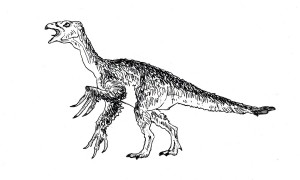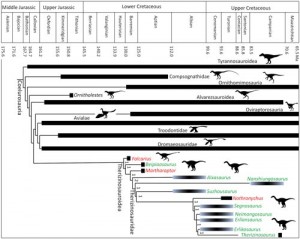A Dinosaur Named “Martha” is Scientifically Described
Martharaptor Named in Honour of Dedicated Employee of Utah’s Geological Survey Team
The exposed Early Cretaceous strata of Eastern Utah (United States), may not be quite as famous as the Upper Jurassic Morrison Formation when it comes to dinosaur fossil finds but recent work by state palaeontologists and the Geological Survey Team of Utah is beginning to reveal an extensive and rich, ancient fauna which was dominated by the Dinosauria.
This part of eastern Utah, with its dry, arid and harsh environment, has already provided palaeontologists with a number of unique dinosaur fossil discoveries and now a new theropod dinosaur has been named and described from the area. The dinosaur, known as Martharaptor greenriverensis has been named to honour the contribution made by Martha Hayden who for more than twenty years has worked to uncover the rich array of vertebrate fossils to be found in the area.
Cedar Mountain Formation
The Cedar Mountain Formation that is exposed around the Green River region of eastern Utah lies on top of the Upper Jurassic Morrison Formation. The layers of sedimentary rock that make up this part of the geological record of the western United states is divided into stratigraphic levels known as members. A primitive example of the therizinosaur dinosaur clade (Scythe Lizards) has already been named and described from some of the oldest rocks laid down at the very beginning of the Cretaceous.
Falcarius utahensis
This dinosaur is known as Falcarius utahensis, recent field work has identified the fragmentary fossilised remains of another possible member of the therizinosaurid clade, but this time from younger rocks at a higher stratigraphic level in the Cedar Mountain Formation. Although palaeontologists would like to find more skeletal material to be absolutely sure that they have found another herbivorous therizinosaur, the dinosaur has been described as the holotype for a new genus of therizinosaur known as Martharaptor greenriverensis.
An Illustration of a Typical Therizinosaur
Picture credit: Everything Dinosaur
Therizinosaurid Dinosaurs
The therizinosaurids represent a bizarre group of theropod dinosaurs that seem to have given up their meat-eating ways and taken up an almost entirely herbivorous diet. Although classified as members of the Coelurosauria, a clade of theropod dinosaurs that also includes the likes of Tyrannosaurus rex, the therizinosaurs seem to have adapted to a browsing and grazing habit. Fossils of therizinosaurs have been found in Asia and North America.
The fossils almost exclusively date from the Cretaceous geological period, with the exception of one, controversial Chinese fossil find that places therizinosaurids in the Early Jurassic. A single fossil lower jaw has been tentatively described as therizinosaur material, this dinosaur has been named Eshanosaurus deguchiianus. This specimen has been dated to around 195 million years ago, pre-dating any other known therizinosaur fossil material by more than sixty million years. This dinosaur was named to honour the Chinese county where it was found (Eshan county) and an influential Chinese scientist called Hikaru Deguchi who helped inspire a number of palaeontologists at the Institute of Vertebrate Palaeontology and Palaeoanthropology in Beijing.
A New Therizinosaur
This latest potential addition to the therizinosaur clade has been named to honour Martha Hayden, an assistant to a number of state palaeontologists and an archivist at the Utah Geological Survey. Unlike the Chinese Early Jurassic fossil find where the genus name cites the location of the discovery whilst the species name honours an influential person in palaeontology, in the Utah discovery’s case; it is the genus that honours a person (Martha Hayden) whilst the species name of this holotype cites the location of this fossil discovery (Green River area of Utah).
Martha has worked for more than two decades assisting a number of palaeontologists and geologists and is a keen field worker, happy to get involved with digs and dinosaur excavations. Her contribution has been recognised by having her own dinosaur genus named after her.
Martharaptor greenriverensis
When asked about her dinosaur, Martha is reported to have said that she is a “little bit embarrassed” by all the fuss but she did concede that her mum was very pleased and proud, after all, not many people get a dinosaur named after them. Martha greenriverensis is known from a disarticulated and jumbled collection of bones that were found within two metres of each other in a mudstone block. The bones probably represent a single individual.
The fossil material collected represents fragments of vertebrae, a scapula (shoulder bone), elements of the limb bones and an ischium (hip bone). Amongst the fossilised remains, some of which were too badly eroded and fragmentary to identify, were several fossils of the claws on the hands (manual unguals) and elements of the feet (pedal unguals). It is from an analysis of the morphology and characteristics of the hand claws that has led scientists to place this dinosaur amongst the therizinosaurids.
Taxonomic Relationships between the Theropoda
Picture credit: PLoS One
Field teams from the State Geological Survey hope to find further remains at the quarry where the first fossils of this new dinosaur were excavated. Hopefully, with the discovery of more fossil material, a better understanding of the taxonomic relationship between Martharaptor and other Early Cretaceous (Barremian faunal stage) theropods can be established.
To view models and replicas of Early Cretaceous theropods including therizinosaurs: CollectA Deluxe Scale Models of Dinosaurs.



